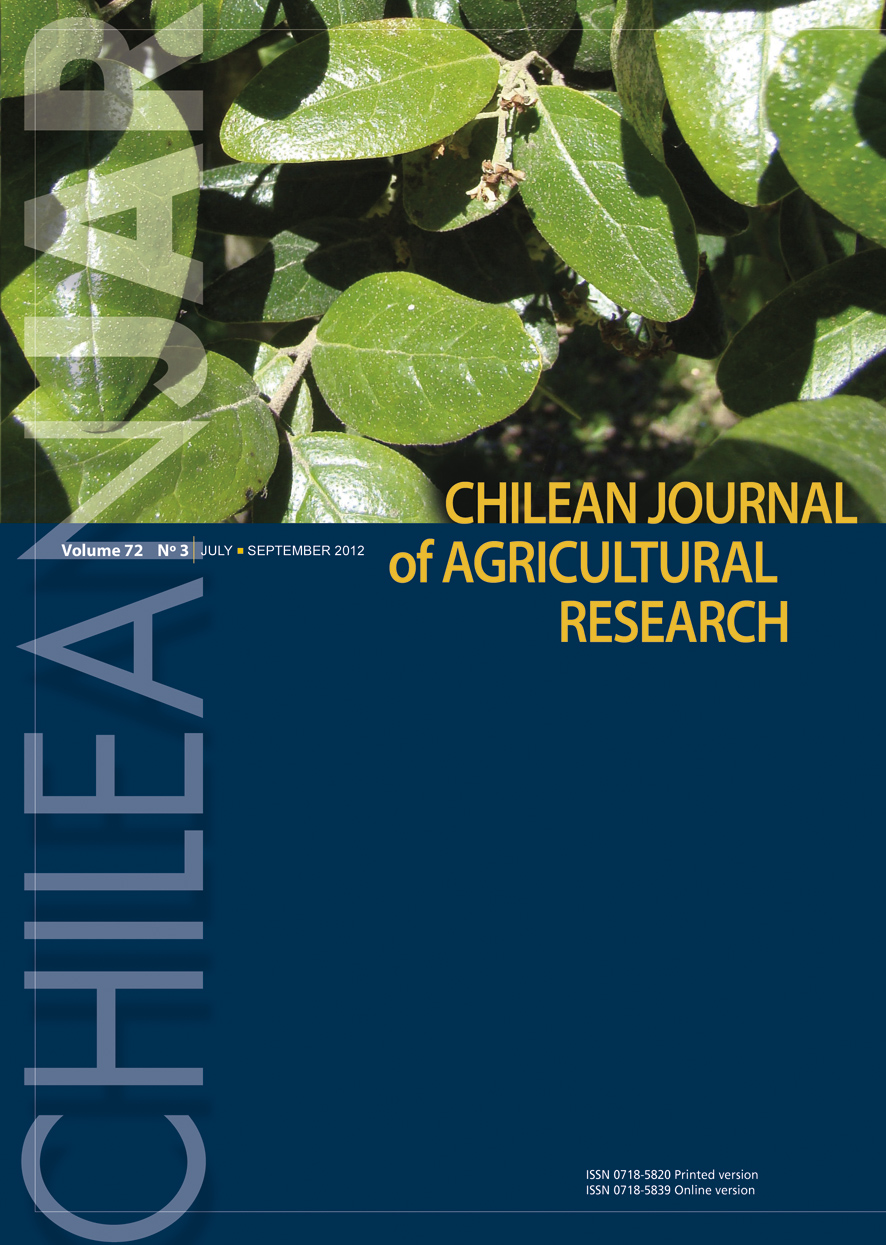
|
Chilean Journal of Agricultural Research
Instituto de Investigaciones Agropecuarias, INIA
ISSN: 0718-5820
EISSN: 0718-5820
Vol. 70, No. 4, 2010, pp. 590-595
|
 Bioline Code: cj10066
Bioline Code: cj10066
Full paper language: English
Document type: Research Article
Document available free of charge
|
|
|
Chilean Journal of Agricultural Research, Vol. 70, No. 4, 2010, pp. 590-595
| en |
Effect Of Split Nitrogen Applications On Durum Wheat Cultivars In Volcanic Soil
Hirzel, Juanc; Matus, Iván & Madariaga, Ricardo
Abstract
Durum wheat (Triticum turgidum L. var. durum) is an important crop for the world population and occupies a large cultivated area worldwide. New cultivars need constant improvement of their agronomic management, within which N fertilization is highlighted. Durum wheat is also important in Chile where genetic breeding and agronomic management have been developed to increase yield, industrial, and nutritional grain quality. The objective of this experiment was to determine the appropriate number of N applications during a crop cycle in a volcanic ash soil in South Central Chile. Nitrogen split applications were carried out on three durum wheat cultivars in a Melanoxerands soil during the 2003-2004 and 2004-2005 seasons. A rate of 200 kg ha-1 N was applied at different growing stages including planting, tillering, flag leaf, and heading (200-0-0-0, 100-100-0-0, 66-67-67-0, and 50-50-50-50 kg N ha-1, respectively). The evaluated traits were grain yield, hectoliter weight, and wet gluten content. Results indicated that the use of two and three split N applications increased grain yield and wet gluten content with differences among genotypes. The best N split strategy corresponded to two and three N splits: at planting and tillering; at planting, tillering, and flag leaf, respectively.
Keywords
durum wheat, cultivars, nitrogen, split applications, Triticum turgidum var. durum, volcanic soil.
|
| |
| es |
Efecto de aplicaciones parcializadas de nitrógeno sobre cultivares de trigo candeal en un suelo volcánico.
Hirzel, Juanc; Matus, Iván & Madariaga, Ricardo
Resumen
El trigo candeal (Triticum turgidum L. var. durum) es un alimento importante para la población mundial ocupando una amplia área de cultivo. Las nuevas variedades necesitan constantes ajustes en su manejo agronómico, dentro del cual destaca la fertilización nitrogenada. El trigo candeal es también importante en Chile, para el cual se ha desarrollado mejoramiento genético y manejo agronómico, con el objetivo de incrementar el rendimiento y calidad nutricional del grano. El objetivo de este experimento fue determinar el número adecuado de aplicaciones de N durante el ciclo del trigo candeal en un suelo volcánico del centro sur de Chile. Durante las temporadas 2003-2004 y 2004-2005 se realizaron experimentos de campo en un Melanoxerands, con aplicaciones parcializadas de N en tres variedades. Una dosis de 200 kg N ha-1 fue aplicada en diferentes estados de crecimiento con combinaciones que consideraron siembra, inicio de macolla, hoja bandera y espigadura (200-0-0-0, 100-100-0-0, 66-67-67-0 y 50-50-50-50 kg N ha-1, respectivamente). Los parámetros evaluados fueron rendimiento de grano, peso del hectólitro y contenido de gluten. La aplicación de N en dos y tres parcialidades incrementó el rendimiento y contenido de gluten, con diferencias de rendimiento entre las variedades evaluadas. La mejor estrategia de parcialización de N correspondió a dos y tres parcialidades; en siembra e inicio de macolla; y en siembra, inicio de macolla y hoja bandera, respectivamente.
Palabras-clave
trigo candeal, trigo duro, cultivares, nitrógeno, aplicación parcializada, Triticum turgidum L. var. durum, suelos volcánicos.
|
| |
© Copyright 2010 Chilean Journal of Agricultural Research.
Alternative site location: http://www.inia.cl
|
|
